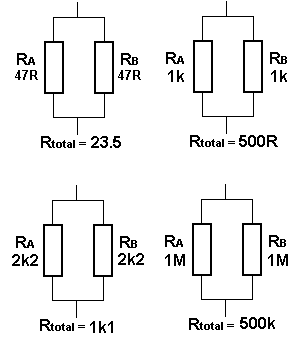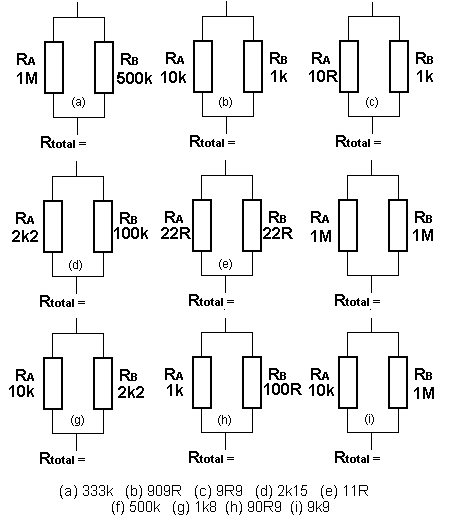|
BASIC
ELECTRONICS COURSE
Page 6  INDEX
INDEX

RESISTORS
IN PARALLEL
Any number of
resistors can be placed in PARALLEL and their combined value is
worked out by the following formula:

This is a fairly
difficult equation to solve, so a RESISTORS
IN PARALLEL calculator has been included.
There are a number of reasons why two or more resistors
are placed in parallel:
1. To obtain a "Special" value - one that is not a
standard value
2. To create a higher wattage resistor.
3. To "trim" a resistor
4. To create an accurate value
Normally two
resistors in parallel will be able to do this and our notes cover
2
RESISTORS IN PARALLEL.
There's a very
simple way to work with parallel resistors. If you need to
put two resistors in parallel (to obtain a higher wattage, for
example), use TWO EQUAL VALUE
resistors. This will make the mathematics very simple.
When two equal value resistors are placed in parallel, the
result is HALF the resistance of either resistor.
For example:
two 10k resistors in parallel produces a value 5k (very close to
4k7)
two 2k2 resistors in parallel gives 1k1 (close to 1k)
two 470R resistors gives 235R (close to 220R)
two 10R resistor in parallel gives 5R

The same applies to
3 resistors in parallel = 1/3 value. E.g: 1k, 1k, 1k in
parallel gives: 330R. This is a very handy fact to remember as it
saves mathematics.
If you need to combine unequal values, the following RESISTORS
IN PARALLEL calculator will be needed:
To use the RESISTORS IN PARALLEL calculator:
Insert the value for each resistor in the box provided and press ANSWER:
The
calculator will also work in reverse. If you know the total
resistance of the combination and the value of one of the
resistors, the calculator will determine the value of the other
resistor.
Note:
If you get a negative answer, the values you have
supplied are incorrect.
PROBLEMS:
Use the calculator above to
determine the answers:

REMEMBER:
When two resistors are placed in parallel, the resistance across the combination is LESS THAN the lower resistor.
STANDARD FORM
The value of a resistor is presented in a STANDARD way. For values up to 1,000 ohms, the letter R (R for
resistance) is placed after the value of resistance. For values 1,000 ohms to
999,999 ohms the letter "k" is used. (k for
kilo). For values above 1,000,000 the letter M is used. (M for Mega)
If the value is 8.2 ohms the value can be written 8.2R
If the value is 1,500 ohms, the answer can be written 1.5k
If the value is 2,200,000 ohms the value can be written 2.2M
But the decimal point can be lost in a printing or photocopying
process so the letters "R, "k" and "M"
are inserted in place of the decimal point: For example:
8R2, 1k5, 2M2
When using the
calculator above you must change the value from Standard Form
to pure numbers e.g: 8R2 becomes:
8.2
1k5
becomes: 1500
2M2 becomes: 2200000
then convert the answer
back to standard form.
NEXT

| 

